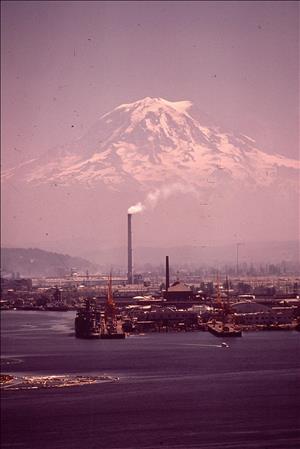On July 2, 2006, the 500-foot Kaiser Aluminum smokestack – a 38-year fixture on the Tacoma waterfront – is demolished to make room for Port of Tacoma expansion of marine terminals along the Blair Waterway. The Kaiser Aluminum Corporation produced aluminum at the site from 1947 to 2000, adding the smokestack to its operations in 1968. Outmoded and aging facilities, along with labor strife in 1998-2000 and spiking energy costs in 2000, led to the plant's closing in June 2000. Kaiser pointed to a weak economy, low aluminum prices, and litigation related to asbestos claims when it sought bankruptcy protection in 2002. The company would never reopen its Tacoma smelter. On April 14, 2003, the Port of Tacoma officially took over Kaiser's 96-acre site and began plans to raze 75 buildings, including the smokestack, thus clearing ground for additional terminal capacity at the port.
Aluminum Boom and Bust
The former Kaiser Aluminum site covers 96 acres on the east side of the Port of Tacoma's Blair Waterway. Aluminum was produced on the site beginning in 1942, when the federal government built a plant to support World War II production efforts. The plant was operated by the Olin Corporation until 1945 and then sat idle until industrialist Henry J. Kaiser (1882-1967), builder of the Hoover and Grand Coulee dams, bought it in 1947 for $3 million. The Tacoma site became the Kaiser Aluminum Corporation's first wholly owned aluminum plant. The later-doomed 500-foot concrete-and-steel smokestack was built in 1968.
At the height of operations, Kaiser's Tacoma plant employed more than 350 workers and produced 161 million pounds of aluminum a year, helping turn Washington into the nation's largest aluminum producer. But the aging facility last produced metal in mid-2000. A bitter 20-month strike and subsequent lockout, all told lasting from 1998 to 2000, was the beginning of the end for the plant. The then-Texas-based Kaiser, headed by billionaire Charles Hurwitz's Maxxam Inc., operated the plant with replacement workers during the lockout and hired only 40 union workers back at the end of the dispute.
But just months after the labor settlement, skyrocketing energy costs led Kaiser to shutter the Tacoma plant entirely in June 2000, followed six months later by cutbacks at its Mead smelter in Spokane. Instead of making aluminum at its Northwest facilities, Kaiser resold the power it had contracted from the Bonneville Power Administration, to the tune of $460 million in profits. This windfall did nothing to save the Tacoma plant. Kaiser entered bankruptcy in February 2002, and as part of its reorganization it sold the Blair Waterway site to the Port of Tacoma in 2003 for $12.1 million in cash.
Land Changes Hands
On April 14, 2003, the Port of Tacoma officially took over the Kaiser site, one of the largest pieces of land on the Tacoma Tideflats, making way for future Port expansion. "One of our greatest strengths always has been the availability of land to attract new customers and offer our existing customers room for growth," port commission president Dick Marzano said at the time ("Port Purchases Tacoma Landmark," 14).
But first would come demolition of the site's 75 buildings, including the 500-foot smokestack, and environmental remediation. As part of the deal, the Port put $4 million in escrow for cleanup of contaminants, which included polyaromatic hydrocarbons, fluorides, and trace amounts of cyanide. The smokestack itself needed to be scrubbed too, an inch-and-a-half layer of soot coated the tower's inside and amounted to 100 tons of waste. A more pleasant surprise greeted the Port as it recycled more than 150 million pounds from the Kaiser site, including steel, copper, aluminum, lead, concrete, alumina ore, oil, and carbon anodes. The scrap metal turned out to be worth millions of dollars. "It's a function of the size of the project, the type of project, what was left here and the rising price of metals," Bill Evans, the Port's environmental program manager, told the Tacoma News Tribune during cleanup in 2005 (Kearsley, "Old Smelter").
And Boom! Again
In 2006, the date for demolition was set: Sunday, July 2, would be the landmark smokestack's final demise. After the tons of soot were removed and shipped to Oregon for disposal, a demolition crew from Salt Lake Seismic Services took over. They placed dynamite in more than 200 holes at the base of the 500-foot cylinder, and they targeted its fall for a graded dirt pad, putting an orange rock where they estimated the top of the stack would land. At 8:03 a.m., two charges were detonated milliseconds apart and sent the tower straight to its target. The explosion was initiated by computer, but Eugene Whitcombe, a Kaiser plant worker for 36 years, pushed down a ceremonial plunger to signal the blast.
An initial boom! was heard, followed seconds later by another boom! as the 38-year-old tower crashed into the ground, sending clouds of dust billowing into the air. "I wish they would have left the thing standing," said Whitcombe, who was joined in his duties by his 3-year-old grandson. "[The smokestack] was something, you know, you always see" (Montes).
A Port of Tacoma spokesman Mike Wasem emphasized that the demolition and cleanup of the old Kaiser site would make room for the new. "What it will become again is productive," he said. "It'll become a site that supports jobs for our region" (Montes). By June 2008, additional plans for the east side of the Blair Waterway bore out this view. Demolition on the rest of the Blair-Hylebos Peninsula was getting underway in earnest to make room for a new 168-acre container terminal. The terminal was slated to house the Tokyo-based NYK shipping line, which in 2007 announced it would end its more than century-long relationship with the Port of Seattle and move to Tacoma.

